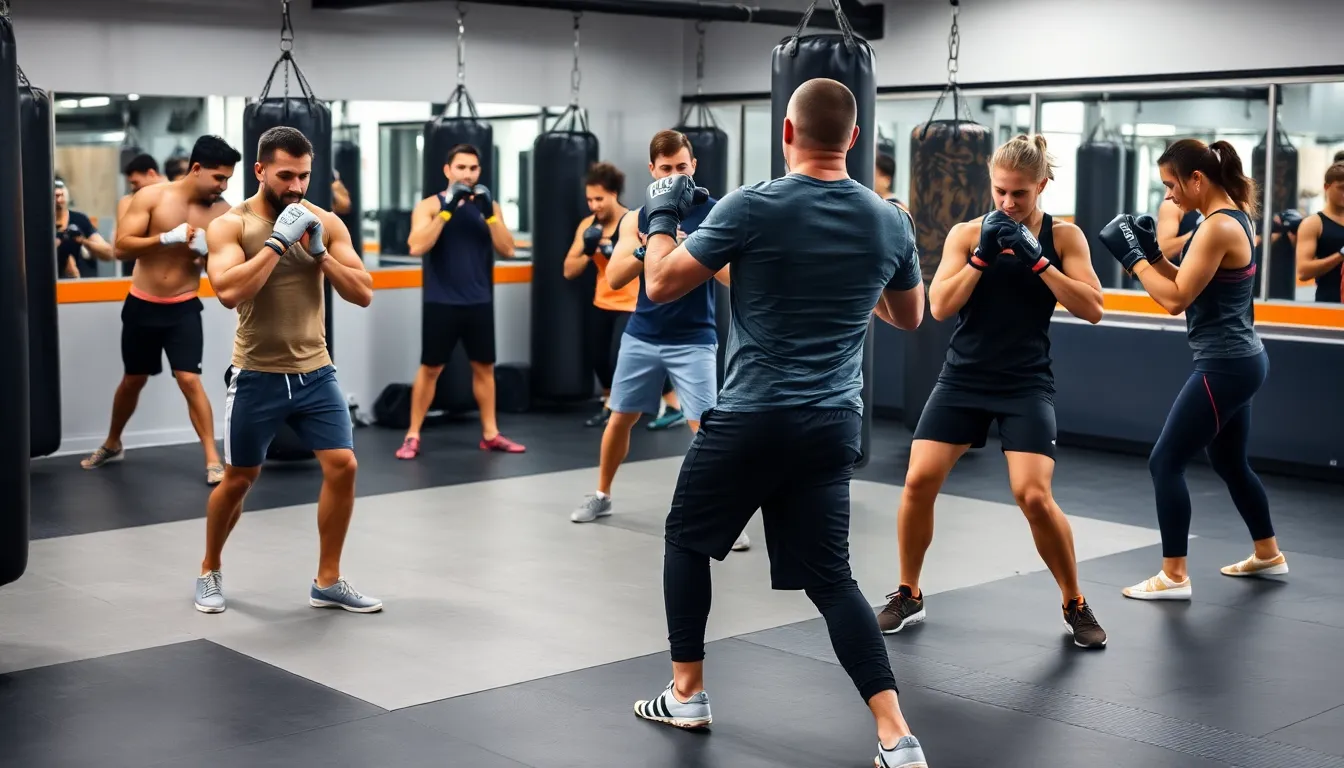In a world where couch-sitting seems to be an Olympic sport, combat fitness emerges as the superhero of workouts. Forget the boring treadmill; it’s time to unleash your inner warrior. Whether you’re looking to channel your favorite action star or simply want to defend yourself against overzealous pizza delivery folks, combat fitness packs a punch—literally and figuratively.
Combat Fitness
Combat fitness refers to a training style that blends physical conditioning with techniques from various martial arts and combat sports. This approach not only enhances strength and endurance but also teaches self-defense skills. Participants in combat fitness programs engage in challenging routines involving striking, grappling, and agility drills.
Such training provides multiple benefits. Improved cardiovascular health ranks among the top advantages, with participants often experiencing elevated heart rates during intense sessions. Building muscle tone and increasing flexibility serve as additional outcomes achieved through regular combat fitness workouts.
Individuals take inspiration from various martial arts, including boxing, Muay Thai, Brazilian Jiu-Jitsu, and more. By incorporating elements from these disciplines, combat fitness creates a diverse workout that keeps participants engaged and motivated. Skills acquired through practice also include coordination, balance, and spatial awareness.
Moreover, this fitness style promotes mental resilience. Participants often face demanding challenges, pushing their limits while developing discipline and focus. The camaraderie built within training groups boosts motivation, fostering a sense of community among participants.
When it comes to accessibility, combat fitness welcomes individuals of all fitness levels. Many gyms now offer introductory classes suitable for beginners, ensuring that anyone can participate and benefit. Together, these aspects make combat fitness a compelling choice for those looking to invigorate their workout routines while gaining useful skills in self-defense.
Benefits Of Combat Fitness

Combat fitness offers numerous advantages for participants, enhancing both physical and mental aspects of well-being.
Physical Strength
Combat fitness significantly boosts physical strength. Engaging in striking, grappling, and agility drills develops muscle tone and builds core strength. Regular workouts improve cardiovascular endurance, leading to better overall health. Participants of various fitness levels benefit from increased energy, enabling them to perform daily tasks with ease. The integration of techniques from boxing, Muay Thai, and Brazilian Jiu-Jitsu targets different muscle groups, enhancing strength in a balanced manner. Flexibility also sees improvement, as combat training frequently incorporates dynamic movements, reducing the risk of injury.
Mental Resilience
Mental resilience gets a strong boost through combat fitness. Facing intense challenges during training cultivates discipline and enhances focus. Participants learn to push their limits, building confidence in their abilities. The supportive environment within training groups fosters a sense of community, making it easier to stay motivated. As individuals tackle difficult techniques, they develop perseverance, which translates to other areas of life. Combat fitness not only sharpens self-defense skills but also instills a mindset ready to confront obstacles with determination.
Training Techniques
Combat fitness incorporates various training techniques that enhance overall physical and mental conditioning. Key components include cardiovascular training, strength and conditioning, and flexibility and mobility.
Cardiovascular Training
Cardiovascular training in combat fitness emphasizes high-intensity interval training (HIIT). Participants perform exercises like shadowboxing or jumping rope to elevate heart rates rapidly. This approach significantly boosts cardiovascular endurance, ensuring participants can maintain energy during prolonged activities. Engaging in drills that mimic real fight scenarios also keeps workouts interesting, preventing monotony. Additionally, research indicates that regular cardiovascular training improves lung capacity and increases stamina.
Strength and Conditioning
Strength and conditioning focus on building muscular endurance and explosive power. Drills incorporate body-weight exercises such as push-ups, squats, and lunges alongside resistance training. These activities enhance functional strength, crucial for performing techniques efficiently. Moreover, compound movements target multiple muscle groups at once, maximizing training efficiency. Trainers often use kettlebells and medicine balls to add variety and challenge. These exercises elevate metabolism, helping participants to build lean muscle effectively.
Flexibility and Mobility
Flexibility and mobility are vital components of combat fitness, reducing injury risks. Dynamic stretching prepares muscles for rigorous activity while improving range of motion. Participants often engage in yoga-inspired movements or specific martial arts stretches. Consistent practice enhances overall body awareness and coordination, essential for executed techniques. Furthermore, improved flexibility aids recovery, allowing participants to train more frequently and effectively. Targeted warm-ups lead to increased agility, useful for dodging and countering in sparring scenarios.
Popular Combat Fitness Programs
Combat fitness enthusiasts often explore diverse training styles to enhance their skills and fitness levels. Two popular options are Military Fitness Training and Martial Arts Conditioning.
Military Fitness Training
Military Fitness Training emphasizes functional strength and endurance, using methods tailored to prepare participants for the physical demands of military service. Routines typically integrate calisthenics, running, and high-intensity obstacles, promoting cardiovascular health and overall toughness. Engaging in team-oriented drills fosters camaraderie, creating a supportive training environment. Programs like Army Combat Fitness Test (ACFT) focus on key performance areas, including sprinting, lifting, and endurance exercises. This structured approach benefits individuals aiming to enhance their fitness level while developing self-discipline and resilience.
Martial Arts Conditioning
Martial Arts Conditioning encompasses disciplines such as boxing, kickboxing, and Brazilian Jiu-Jitsu, blending technique with fitness. This style prioritizes bodyweight exercises, sparring, and skill drills to elevate strength, flexibility, and coordination. Participants refine their combat skills while engaging in intense cardiovascular workouts. Training typically includes heavy bag work and partner drills, enhancing striking techniques and reaction time. Programs also incorporate mental conditioning, helping individuals develop focus and tactical thinking. Committing to Martial Arts Conditioning results in improved self-defense proficiency and overall physical fitness.
Conclusion
Combat fitness stands out as a vibrant alternative to conventional workouts. It not only enhances physical strength and endurance but also cultivates mental resilience and discipline. Participants experience a unique blend of martial arts techniques and high-intensity training that keeps them engaged and motivated.
The sense of community formed in training groups further enriches the experience, making it accessible and enjoyable for individuals of all fitness levels. With its numerous benefits including improved cardiovascular health and self-defense skills, combat fitness offers a holistic approach to well-being. Embracing this dynamic training style can empower individuals to take charge of their fitness journey while building confidence and camaraderie.

